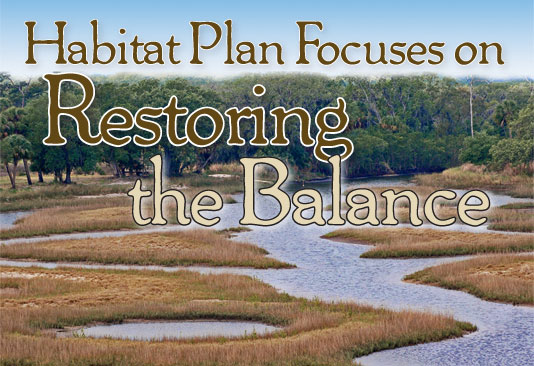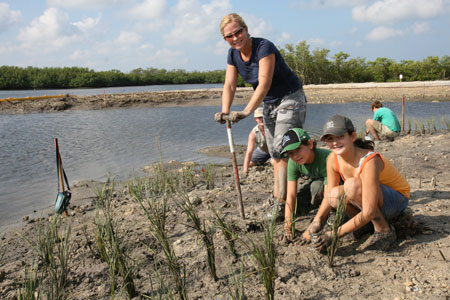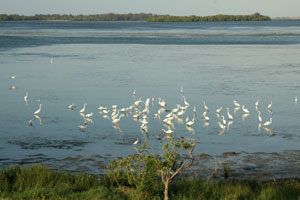 |
||||||||

Photo by Nanette O'Hara
"Braided" marshes at Cockroach Bay help filter nutrients from nearby neighborhoods while providing low-salinity habitat for many species of birds, fish and crabs.
By Susan Ladika
Think of the Tampa Bay estuarine area as one big jigsaw puzzle. A piece of salt marsh here, a bigger piece of mangroves there, a tiny piece of salt barren — a high salt marsh also known as a saltern — in this corner and they should all fit together.
Over the years, development has taken away sections of the various habitats, piece, by piece, by piece.
Now environmental experts in the Tampa Bay area are working to put the habitats back together again. “Some pieces are small, some pieces are large. When you put all the pieces together, then you start to see the cumulative benefit,” says Brandt Henningsen, chief environmental scientist for the Surface Water Improvement and Management (SWIM) program, run by the Southwest Florida Water Management District (SWFWMD).
Henningsen was part of a team of environmental scientists who worked on a newly completed update to the Tampa Bay Estuary Program’s Habitat Master Plan for the bay watershed.
The original plan, completed nearly 15 years ago, set restoration targets for the mangroves, salt barrens and salt marshes rimming Tampa Bay. It called for a “Restoring the Balance” approach that focused on restoring habitats in relative proportion to their historic acreages in 1950. The 1950s were chosen as the benchmark because significant scientific data and aerial photographs exist to tell scientists how much, and what types of habitats, were present then. Scientists also believe those habitat ratios and acreages can reasonably be achieved today.
Because of the intense development in the area over the decades, “it’s not realistic to restore everything back to its original state,” says Lindsay Cross, TBEP environmental scientist.
Progress Made, But Updates Needed

Photos courtesy Tampa Bay Watch
Planting spartina grass stabilizes low-lying coastal lands and provides food and shelter for many species of fish, crabs and birds.
Tremendous progress has been made in restoring bay habitats since the original master plan was adopted, but analysis of current trends showed scientists that the system is still somewhat out of whack, with mangroves continuing to outcompete other coastal habitats. Thus, the updated plan adjusts the targets for salt marshes and salt barrens upwards to keep pace.
“Our whole goal is to maintain the habitat mosaic,” says Nanette O’Hara, TBEP’s public outreach coordinator.
As of 1950, the area had more than 64,000 acres of mangroves, salt marshes, salt barrens and seagrasses. More than 60% of the acreage was seagrasses, nearly one-quarter was mangroves, about 10% was salt marshes and 2% was salt barrens.
With the development boom that changed ecosystems across the region, the total number of acres of the various habitats had dwindled to about 46,000 when the first report was completed in 1996. By 2007-2008, the acreage had expanded to nearly 50,000 acres. The biggest change was that mangroves had thrived at the expense of other coastal habitats, expanding to more than 30% of the total acreage.
Achieving a balance of habitats is crucial because various creatures require certain habitats to survive. While some critters spend their whole lives in one type of habitat, others move from habitat to habitat over the course of their lifetimes.
Ultimately, scientists would like to see more than 60,000 acres of seagrasses, mangroves, salt marshes and salt barrens, in proportions similar to what they were in the 1950s. That means bringing back 8,000 acres of seagrasses, nearly 2,000 acres of salt marshes, and 840 acres of salt barrens. If that doesn’t happen, the Tampa Bay area could see “fewer fish, bird and wildlife species,” Cross says.
Mangroves Thrive, Salt Barrens Miss Target

Nearly 400 volunteers planted 34,000 plugs of salt marsh at the Terra Ceia Ecosystem Restoration Project in 2007.
Mangroves have thrived because warmer temperatures overall in the region (last winter’s record cold not withstanding) have meant mangroves haven’t been killed off by freezes, as they normally would be. On the other hand, salt barrens have taken a hit because they tend to be higher and drier, making them prime targets for developers building homes for residents who want to live near the water.
Across the board, restoration of Tampa Bay’s critical habitat has shown strong progress. Since 1982, about 6,000 acres of seagrasses have been recovered, and in the nearly 15 years since the first master plan was adopted, more than 5,000 acres of coastal wetlands and upland habitats have been restored or enhanced.
While the updated report establishes numeric restoration goals, no deadlines are mandated. That’s because scientists “can only move as fast as you have money and manpower to do so,” Henningsen says.
The original report targeted 28 sites for acquisition, protection, restoration or management. Since then, all or part of 19 of those sites have been purchased, and restoration work has taken place on eight of them.
The new plan identifies 44 more publicly owned sites in Hillsborough, Manatee and Pinellas counties, as well as seven new sites for potential public-private partnerships. Having those sites on a priority list should make it easier to proceed if any become available for restoration. “It lends credibility to purchases,” Cross says.
Cross says that in the early days of habitat restoration, projects typically consisted of restoring small areas containing marshes. With time and experience, restoration efforts have matured into larger projects covering multiple types of habitat, and scientists have been able to monitor long-term success, while honing their restoration knowledge and skills.
Restoration Efforts Face Catch-22
But they now face a catch-22. The real estate bust has made land available at reasonable prices, but there’s little money in governmental coffers to make such purchases, Henningsen says.
What money there is continues to be put to good use. Right now the SWIM program is working on restoring about 1,000 acres of land once owned by Tampa Electric Co. south of Cockroach Bay called the Rock Ponds tract.
A dramatic transformation is taking place, plotted out on aerial photographs of the area that tell scientists what’s there currently, and what they want the restored area to look like as funds become available. Features are added like a lagoon and restoring a freshwater slough that once existed there.
With any restoration project, the environmental experts look at “what used to be there and what’s there now,” Henningsen says, and then determine, “Can we restore the original? If not, what can we create or enhance?”
The Rock Ponds project is in the early design stages, and should take three to four years to complete at a cost of about $10 million.

Birds flock to restored habitats at Terra Ceia.
Henningsen also expects more public-private partnerships to emerge, like the one between SWIM and Tampa Electric Co. at Newman Branch Creek in Apollo Beach, where public money was used on private land to restore about a dozen acres near the power plant’s Manatee Viewing Center. TECO has placed the land in a permanent conservation easement so it can never be developed. Invasive plants were removed from the site of the former tropical fish farm, native plants were planted, and the area was transformed back into wetlands and salt barrens.
To support efforts such as these, a Tampa Bay Habitat Restoration and Protection Partnership has been created, as recommended by the master plan update. The group’s members will work together to set priorities, identify funding and partnership opportunities and monitor progress on the master plan’s goals.
Acquiring land and then restoring multiple habitats is “not an overnight fix,” Henningsen says. And even one or two major projects can’t complete the transformation. It takes hard work at multiple sites over many years. Because the bay’s ecosystem lost habitat over many years, rather than in one fell swoop, “restoration is exactly the same.”
And even if the plan’s targets are reached, that doesn’t mean work will be complete. Predicted sea-level rise could eventually inundate areas that have already been restored, he says, creating demand for new restoration projects and making the work “kind of a never-ending job.”
